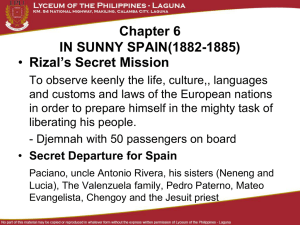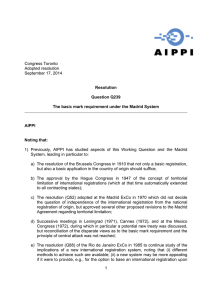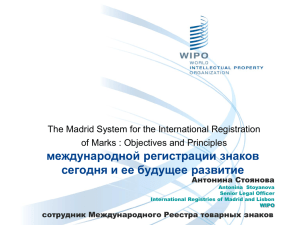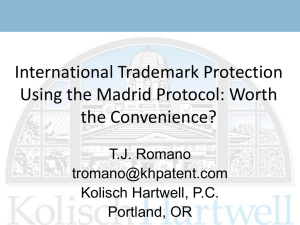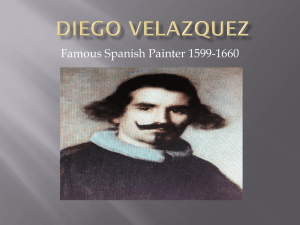THE MADRID PROTOCOL
advertisement
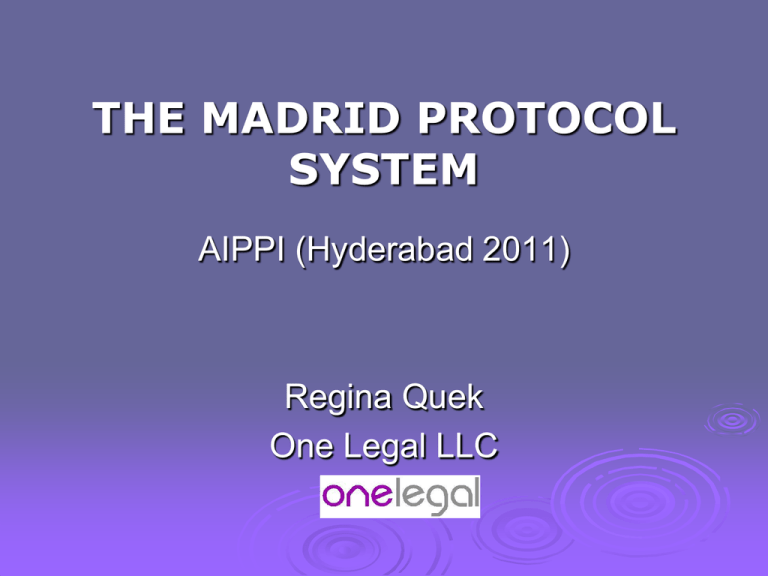
THE MADRID PROTOCOL SYSTEM AIPPI (Hyderabad 2011) Regina Quek One Legal LLC Background The system of international registration of marks is governed by the Madrid Agreement (1891) and the Protocol - adopted in 1989, entered into force on December 1, 1995, and came into operation on April 1, 1996. - administered by the International Bureau of WIPO The Madrid Protocol has now 84 members, including the European Community (since October 2004), Japan, South Korea, China and USA The Madrid system enables a trademark owner to obtain protection for his trademark in several countries by: filing one application directly with his national or regional trademark office, paying application fees in a single currency The quantum of fees in each application would of course depend on the number of countries and classes designated in that application An international registration is: a bundle of national registrations as if filed directly in the national or regional offices designated same force and effect as a registration in that jurisdiction. In this regard it is different from a unitary registration such as the Community Trade Mark. Because it is a bundle of separate national rights – it can be treated as such. national/regional A Madrid Protocol application may result in different scopes of protection - in each country in that protection may be refused (totally or partially) by some of the designated Contracting Parties Protection may be more limited in some countries than others Protection may be renounced for only some of the designated Contracting Parties All the above without affecting rights in the other designated countries A Madrid Protocol application is also flexible in terms of the ownership of the rights – in that the rights in some countries may be separately assigned to another party (i.e. eligible under the rules of the MP) without affecting the rights in other designated countries. The rights are also to be separately enforced – an action for infringement of an international registration are to be brought separately in each of the Contracting Parties concerned. Madrid Protocol application: An option that ought to be considered by both trademark owners and practitioners as a possible mode of obtaining multi-jurisdictional protection of trademarks Pre-Requisites to File an Application Under Madrid Protocol 1. Entitlement to file The Applicant must have the necessary connection to a member of the Protocol, i.e. the Applicant must: .. be a national of .. is domiciled in, or .. have a real and effective industrial or commercial establishment in a Contracting Party to the Madrid Protocol. In the present context - an Indian company will not be entitled to file a Madrid Protocol application unless it has a real and effective industrial or commercial establishment in a member country, e.g. Singapore. This requirement applies to all co-Applicants and assignees. 2. Basic Application or Registration Basic pending application or granted registration in a Contracting Party where the Applicant has connection; 3. The Madrid Protocol Application Must Correspond to the Basic Application/Registration the mark in the Madrid application must be the same as that in the basic application/registration; the applicant of the Madrid applicant must be the same as the proprietor of the basic application/registration, and the goods and/or services of the Madrid application must be within the scope of the basic application/registration Effect: Protocol route may not be suitable where different language marks are used in different countries. No series marks application available. Affects ownership arrangements for trade marks – for example within different companies in a Group practices of the Office of Origin in examination of specifications may affect scope of protection of the mark in different jurisdictions 4. Dependence on Basic Registration / Application Dependency of an IR on the Basic Registration / Application for a period of five years from the date of its registration. If, and to the extent that, the basic application or registration ceases to have effect within this fiveyear period, the IR will no longer be protected. This means - IR is vulnerable in this 5-year period to a ‘central attack’ on the Basic application / registration. Transformation - The IR may be transformed into national registrations in the event of a successful central attack After the expiry of this period of five years, the international registration becomes independent of the basic registration or basic application. Limitations of the Madrid Protocol route Some limitations inherent in the Madrid Protocol system: The proprietor of the IR must have necessary connection to a Contracting Party to the Protocol. This limitation will impact future exploitation strategies of the owner for example in the sale/assignments of his rights The effect of the requirement for and conditions for Basic application or registration :• may limit strategies for ownership arrangements within an organization; • the law and practice of the Country of Origin may have an impact on the scope of protection of the mark in different jurisdictions. • the system does not cater to simultaneous registration of marks in different languages . • vulnerability for a 5 year period to a central attack on the Basic application/ registration. Advantages of the Madrid Protocol system Administrative and procedural simplification and cost savings • • The Madrid system enables a trademark owner to obtain protection for his trademark in several countries by filing one application directly with his national or regional trademark office, • in one language, and • By paying one fee to one office instead of • filing separate applications • in several countries; • in different languages, and • paying separate fees in separate currencies to each trade mark office. No local representative required in each jurisdiction at the time of filing -> significant cost savings for the Applicant A local agent is required only when a refusal is issued in a country i.e. prosecution costs only incurred on a need- to basis Administrative convenience - certain matters such as recordals of changes, assignments, limitations of goods and renewals can be effected by recordals with the International Bureau as one centralized body. Please note however that all such recordals are subject to national laws and contracting parties may file a Declaration (within 18 months) that the said transaction has no effect in respect of that contracting party. For example Singapore has filed a Declaration that the recording of licenses in the International Register has no effect in Singapore – therefore licenses will still have to record nationally in Singapore. Cost savings: But it will still mean that there is no need to appoint local representatives in each country unless necessary. Speed of registration process: The applicant - does not have to wait for a positive response from the office of each contracting party in which protection is sought. If no refusal is notified by the trade mark office in a designated country within the applicable time limit, the mark is protected in the contracting party concerned. This may result in a more rapid registration process for countries where their usual processing time exceeds 18 months. For countries where the processing time is shorter than the 12 or 18 months, the Madrid Protocol system may actually mean a longer processing time. SINGAPORE Singapore acceded to the Protocol on 31 July 2000 and the Protocol came into force in the Republic of Singapore on 31 October 2000. Filing an International Application with Singapore as the Country of Origin: The application must be filed with IPOS. The relevant forms: Form MM2(E); IPOS Form MP3 (official form of the national office) MM 18 (E) Declaration of intention to use in USA Payment: national administrative fee (local currency) international application fee payable to WIPO (in Swiss Francs) consisting of: • • basic fee individual fees – the amount of these fees will vary with the number of countries and classes designated. The fees specified by each country will vary. There is a fee calculator available on the WIPO website that assists applicants in the calculation of the fee payable. Processing by IPOS After receipt of an International Application IPOS will: send acknowledgement letter to applicant conduct formalities check notify applicant of irregularities ( if any) send the IA to the International Bureau if it is in order, and notify the applicant. Processing by International Bureau Where IA complies with requirements - recorded in the International Register and published in the WIPO Gazette of International Marks. The IB notifies each Contracting Party in which protection has been requested. Each designated Contracting Party has the right to refuse protection, within the time limits specified in the Madrid Protocol. Unless such a refusal is notified to the IB within the applicable time limit, the protection of the mark in each designated Contracting Party is the same as if it had been registered by the Office of that Contracting Party. The time limit for a Contracting Party under the protocol is 12 months unless specified to be 18 months e.g. Singapore In the next slide – I am setting out the statistics for IR applications received by Singapore. The MP took effect in Singapore on 31 October 2000 Applns under Total Madrid (according to class) Protocol 13,021 Year National applns 1998 13,021 1999 15,753 - 15,753 2000 22,131 118 22,249 2001 13,749 6524 20,273 2002 11,623 8452 20,075 2003 12,815 8,472 21,287 2004 14,088 9,163 23,251 2005 14,950 12,036 26,986 2006 15,121 14,095 29,216 2007 16,560 15,600 32,160 2008 16,788 17,422 34,210 2009 2010 15,055 17,446 13,207 13,035 28,262 30,481 80,000 70,000 60,000 50,000 Total (according to class) 40,000 Applications received under Madrid Protocol 30,000 National applications 20,000 10,000 0 1998 1999 2000 2001 2002 2003 2004 2005 2006 2007 2008 2009 2010 International applications filed through Singapore as office of origin Year No. of applications 2001 52 2002 50 2003 70 2004 92 2005 144 2006 169 2007 146 2008 164 2009 211 2010 181 ANALYSIS There is a general trend toward an increase in the total trade mark filings after the implementation of Madrid Protocol. There was a dip in national filings immediately after the implementation of the MP and national filings still hover at about the same level. The greater increase is seen in the increase in the number of Madrid Protocol applications designating Singapore. Practical lessons garnered from the last 10 years Japan has a 2-part fee. Efficient docketing is necessary to ensure that the fee for the 2nd part is not overlooked. While there are costs savings under the MP – the cost will be affected by currency fluctuation for applicants who do not usually trade in Swiss Franc, for example – the Swiss Franc has appreciated about 32% against the USD in the last 12 months Translation may be an issue for the designation in China, Japan and Korea China has a very short response time for their Refusals and this is not extendible - “within 15 days from receipt of this notification” or under local Chinese practice, it is within 30 days from the issuing date of the WIPO’s notice. So getting the assistance of Chinese counsel to check when refusals are issued is a good idea. Declaration of intention to use in USA must be filed if USA is designated Generally we have seen a trend in favour of using the MP from our local clients. THANK YOU Q&A Regina Quek One Legal LLC
